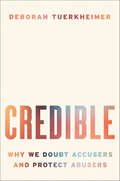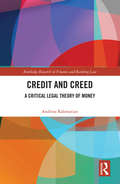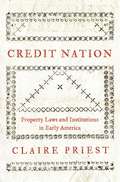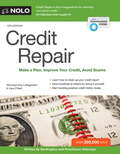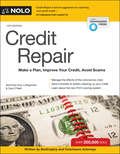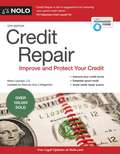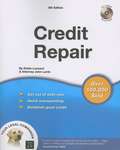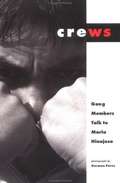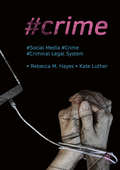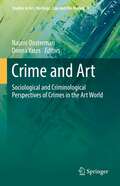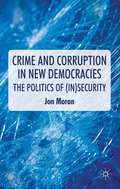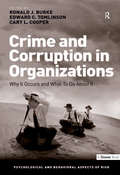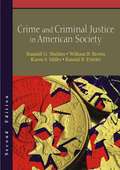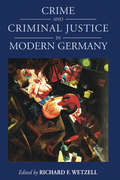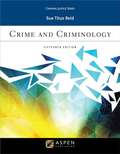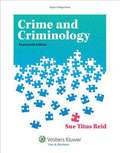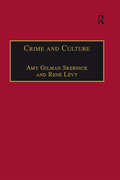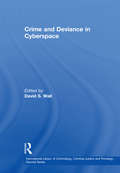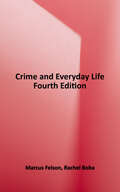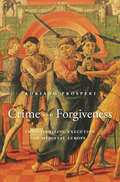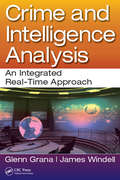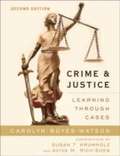- Table View
- List View
Credible: Why We Doubt Accusers and Protect Abusers
by Deborah TuerkheimerIn this landmark book, a former prosecutor, legal expert, and leading authority on sexual violence examines why we are primed to disbelieve allegations of sexual abuse—and how we can transform a culture and a legal system structured to dismiss accusers Sexual misconduct accusations spark competing claims: her word against his. How do we decide who is telling the truth? The answer comes down to credibility. But as this eye-opening book reveals, invisible forces warp the credibility judgments of even the well- intentioned among us. We are all shaped by a set of false assumptions and hidden biases embedded in our culture, our legal system, and our psyches. In Credible, Deborah Tuerkheimer provides a much-needed framework to explain how we perceive credibility, why our perceptions are distorted, and why these distortions harm survivors. Social hierarchies and inequalities foster doubt that is commonplace and predictable, resulting in what Tuerkheimer calls the “credibility discount”—our dismissal of claims by certain kinds of speakers—primarily women, and especially those who are more marginalized. The #MeToo movement has exposed how victims have been badly served by a system that is designed not to protect them, but instead to protect the status quo. Credibility lies at the heart of this system. Drawing on case studies, moving first-hand accounts, science, and the law, Tuerkheimer identifies widespread patterns and their causes, analyzes the role of power, and examines the close, reciprocal relationship between culture and law—guiding us toward accurate credibility judgments and equitable treatment of those whose suffering has long been disregarded.#MeToo has touched off a massive reckoning. To achieve lasting progress, we must shift our approach to belief. Credible helps us forge a path forward to ensuring justice for the countless individuals affected by sexual misconduct.
Credit and Creed: A Critical Legal Theory of Money (Routledge Research in Finance and Banking Law)
by Andreas RahmatianMoney is a legal institution with principal economic and sociological consequences. Money is a debt, because that is how it is conceptualised and comes into existence: as circulating credit – if viewed from the creditor’s perspective – or, from the debtor’s viewpoint, as debt. This book presents a legal theory of money, based on the concept of dematerialised property. It describes the money creation or money supply process for cash and for bank money, and looks at modern forms of money, such as cryptocurrencies. It also shows why mainstream economics presupposes, but avoids an analysis of, money by effectively eliminating money from the microeconomic market model and declaring it as merely a neutral medium of exchange and unit of account. The book explains that money rather brings about and influences substantially the exchange or transaction it is supposed to facilitate only as a neutral medium. As the most liquid of all assets, money enables financialisation, monetisation and commodification in the economy. The central role of the banks in the money creation process and in the economy, and their strengthened position after the bank rescue measures in the wake of the financial crisis 2008-9 are also discussed. Providing a rigorous analysis of the most salient legal issues regarding money, this book will appeal to legal theorists, economists and anyone working in commercial or banking law.
Credit, Consumers and the Law: After the global storm (Markets and the Law)
by Karen Fairweather Paul O'Shea Ross GranthamConsumer law, particularly consumer credit law, is characterised by increasingly complex regulation in Western economies. Reacting to the Global Financial Crisis, governments in the UK, the EU, Australia, New Zealand and the United States have adopted new laws dealing with consumer credit, responsible lending, consumer guarantees and unfair contracts. Drawing together authors from all of these jurisdictions, this book analyses and evaluates these initiatives, and makes predictions as to their likely success and possible flaws.
Credit Nation: Property Laws and Institutions in Early America (The Princeton Economic History of the Western World #104)
by Claire PriestHow American colonists laid the foundations of American capitalism with an economy built on creditEven before the United States became a country, laws prioritizing access to credit set colonial America apart from the rest of the world. Credit Nation examines how the drive to expand credit shaped property laws and legal institutions in the colonial and founding eras of the republic.In this major new history of early America, Claire Priest describes how the British Parliament departed from the customary ways that English law protected land and inheritance, enacting laws for the colonies that privileged creditors by defining land and slaves as commodities available to satisfy debts. Colonial governments, in turn, created local legal institutions that enabled people to further leverage their assets to obtain credit. Priest shows how loans backed with slaves as property fueled slavery from the colonial era through the Civil War, and that increased access to credit was key to the explosive growth of capitalism in nineteenth-century America.Credit Nation presents a new vision of American economic history, one where credit markets and liquidity were prioritized from the outset, where property rights and slaves became commodities for creditors' claims, and where legal institutions played a critical role in the Stamp Act crisis and other political episodes of the founding period.
Credit Repair: Make a Plan, Improve Your Credit, Avoid Scams (13th Edition)
by Robin Leonard Amy Loftsgordon<p>Bad credit can prevent you from getting a mortgage, car loan, credit card, apartment, or even a job. It can also mean paying a bundle in rates and fees for any loans or credit you do get. <p>Use this comprehensive how-to manual to rebuild bad credit and protect improved credit. Learn how to: <p> <li>reduce expenses <li>create a workable budget <li>negotiate with creditors <li>improve your credit score, and <li>protect yourself against identity theft</li> </p>
Credit Repair: Make a Plan, Improve Your Credit, Avoid Scams
by Amy Loftsgordon Cara O'NeillBad credit can get better A bad credit report can prevent you from getting a mortgage, car loan, credit card, apartment, or even a job. The sensible strategies in Credit Repair help you take control of your finances, clean up your credit report and rebuild your credit. Learn how to: prioritize debts and create a budget reduce debts and cut expenses negotiate with creditors correct credit report errors and remove old information add positive information to your credit report adopt strategies to rebuild your credit, and avoid identity theft and credit repair scams. Updates to the 14th edition of Credit Repair include the new FICO scoring system and federal CARES Act credit reporting guidelines, changes to credit freeze and fraud alert laws, the availability of additional free credit reports during the pandemic, and more. With downloadable forms: Get forms, worksheets, and sample letters—to help you handle debts, clean up your credit, and avoid overspending (details inside).
Credit Repair (12th Edition)
by Amy Loftsgordon Robin LeonardWhen debts pile up, it can be impossible to see a way out. And in the meantime, the consequences pile up. Let the sensible strategies in Credit Repair help you take control, clean up your credit report, and live debt-free. assess your debt situation correct errors and improve your credit report and score choose the best repair strategy for your situation prioritize your debts negotiate with creditors to reduce debts add positive information to your credit report avoid identity theft and credit scams build a solid credit history This edition of Credit Repair is completely updated with the latest legal developments, and includes dozens of forms and letters that will help you spruce up your credit report as easily as possible!
Credit Repair (8th edition)
by Robin Leonard John LambLeonard is an attorney and the author or co-author of many of Nolo's personal finance books. Written in plain English, his text explains how to get out of debt, set up a realistic budget, and rebuild "bad" credit. This edition has been completely updated and revised to incorporate the latest information and laws, including new information on identity theft and what to do if you are a victim of it. The text includes 30 forms and letters, both as tear-outs and on the accompanying CD-ROM. Annotation ©2006 Book News, Inc., Portland, OR (booknews.com)
Crews: Gang Members Talk to Maria Hinojosa
by Maria HinojosaHinojosa, a radio reporter, interviews boys and girls who have formed a 'crew'. They feel that it is better to be together than to be with family as they are feared more than respected.
Cricket and the Law: The Man in White is Always Right (Routledge Studies in Law, Society and Popular Culture)
by David FraserCricket, law and the meaning of life ... In a readable, informed and absorbing discussion of cricket’s defining controversies – bodyline, chucking, ball-tampering, sledging, walking and the use of technology, among many others – David Fraser explores the ambiguities of law and social order in cricket. Cricket and the Law charts the interrelationship between cricket and legal theory – between the law of the game and the law of our lives – and demonstrates how cricket’s cultural conventions can escape the confines of the game to carry far broader social meanings. This engaging study will be enjoyed by lawyers, students of culture and cricket lovers everywhere.
#Crime: Social Media, Crime, and the Criminal Legal System (Palgrave Studies in Crime, Media and Culture)
by Rebecca M. Hayes Kate LutherAs research continues to accumulate on the connections between media and crime, #Crime explores the impact of social media on the criminal legal system. It examines how media influences our perceptions of crime, the perpetration of crime, and the implementation of punishment, whilst emphasizing the significance of race, ethnicity, class, gender, and sexuality. It offers an accessible and in-depth examination of media and in each chapter there are case studies and examples from both legacy and new media, including discussions from Twitter that are being used to raise awareness of criminal legal issues. It also includes interviews with international scholars and practitioners from Australia, Belgium, and the United States to voice a range of global perspectives. This book speaks broadly to those interested in criminology, criminal justice, media and culture, sociology, and gender studies.
Crime and Art: Sociological and Criminological Perspectives of Crimes in the Art World (Studies in Art, Heritage, Law and the Market #1)
by Naomi Oosterman Donna YatesThis volume brings together work by authors who draw upon sociological and criminological methods, theory, and frameworks, to produce research that pushes boundaries, considers new questions, and reshape the existing understanding of "art crimes", with a strong emphasis on methodological innovation and novel theory application. Criminologists and sociologists are poorly represented in academic discourse on art and culture related crimes. However, to understand topics like theft, security, trafficking, forgery, vandalism, offender motivation, the efficacy of and results of policy interventions, and the effects art crimes have on communities, we must develop the theoretical and methodological models we use for analyses. The readership of this book is expected to include academics, researchers, and practitioners in the fields of criminology, sociology, law, and heritage studies who have an interest in art and heritage crime.
Crime and Corruption in New Democracies
by Jon MoranCovering countries as diverse as Brazil and Guatemala, Thailand, Russia and occupied Iraq, this book examines the way democratization may lead to changes in crime. Case studies examine violent and sexual crime and their links to political change. The book also explores the way democracy itself may generate cycles of violence sometimes greater than the previous regime as states adopt hard-line policies to crime. However, the author sets democracy and crime in perspective, arguing that organized crime is not the threat to democracy many policy makers and academics claim. Generally, whilst crime and corruption are changed by democratization and crime may rise markedly, democracies are remarkably resilient. This book also examines democratization and corruption, and provides a new perspective on the relationship between the two, arguing that political power has been sidelined in explanations of corruption.
Crime and Corruption in Organizations: Why It Occurs and What To Do About It (Psychological and Behavioural Aspects of Risk)
by Ronald J. Burke Edward C. TomlinsonAlthough increasing attention has been paid to it, there are no signs that crime and corruption in organizations is decreasing, so if you're a manager or government policy maker, and your mandate is to reduce crime and corruption, where do you start? The international authors of this book fill a critical need to address such a prevalent and costly topic with a detailed analysis of the risks associated with crime and corruption in organizations. They examine the causes and consequences, and the choices we face in our efforts to eradicate these social maladies. They focus on the risks to individuals and organizations surrounding criminal and corrupt acts, with an emphasis on the psychological, behavioral and organizational factors supporting such behaviors. Finally, they explore the phenomenon of crime and corruption across a diverse array of organizational settings (ranging from public to private, for-profit to non-profit) and occupational categories (e.g., police officers, physicians, accountants, and academicians). The constant barrage of scandals publicized by the media demands 'front burner' attention dedicated to stemming this tide. Accordingly, this book turns to prominent researchers employing their talents to produce more ethical organizations. The result is the most up-to-date thinking on both classic (e.g., cognitive moral development) and novel (e.g., moral attentiveness) approaches to crime and corruption, as well as scientifically-grounded approaches to reducing illicit behavior in organizations.
Crime And Criminal Justice In American Society
by Randall G. Shelden William B. Brown Karen S. Miller Randal B. FritzlerToday’s headlines vividly illustrate the importance of understanding aspects of the criminal justice system too often ignored. While the second edition of Crime and Criminal Justice in American Society includes the most recent statistics on the police, courts, and corrections, its provocative, current examples also spur critical thinking about justice in the United States. <p><p> The authors offer an alternative interpretation of criminal justice rarely presented in traditional textbooks or by the media. They encourage readers to examine their beliefs about crime, punishment, and the law. Discussions in the chapters about how African Americans, Hispanics, whites, women, juveniles, the rich, and the poor experience crime and the criminal justice system contribute context for understanding different viewpoints. The poor and minorities are the most likely to be caught in the net of criminal justice—but inequities have consequences for everyone. Reflection on various perspectives provides helpful input for assessing attitudes and for becoming actively involved with issues that have significant consequences.
Crime and Criminal Justice in Modern Germany (Studies in German History #16)
by Richard F. WetzellThe history of criminal justice in modern Germany has become a vibrant field of research, as demonstrated in this volume. Following an introductory survey, the twelve chapters examine major topics in the history of crime and criminal justice from Imperial Germany, through the Weimar and Nazi eras, to the early postwar years. These topics include case studies of criminal trials, the development of juvenile justice, and the efforts to reform the penal code, criminal procedure, and the prison system. The collection also reveals that the history of criminal justice has much to contribute to other areas of historical inquiry: it explores the changing relationship of criminal justice to psychiatry and social welfare, analyzes representations of crime and criminal justice in the media and literature, and uses the lens of criminal justice to illuminate German social history, gender history, and the history of sexuality.
Crime and Criminology
by Ph. D. Reid Sue TitusKnown for its unique blend of social science and legal research, Crime and Criminology, Fifteenth Edition uses an interdisciplinary approach to bring a sprawling subject into sharp relief. From the history and theory of criminal law to today’s hot-button topics, leading scholar Reid clearly explains to students how criminology affects and relates to criminal justice policies.
Crime And Criminology, 14th Edition
by Sue Titus ReidProviding a unique blend of social science and legal research, Crime and Criminology offers students a broad context in which to study this dynamic subject, from its history and theories to its ongoing debates and discussions. Features: Provides students with a solid understanding of the integral relationship between the law and theories of criminal behavior Recent updates include the impact of terrorism and the economic downturn on the criminal justice system, victims with disabilities, healthcare and Medicare fraud, and the decriminalization of marijuana for personal use Expanded coverage of rehabilitation and deterrence, statutory rape, elder abuse, domestic violence, intimate partner violence, hate crimes, gun control, property crimes, and more Presents new research on families, twins, adoptees, and how brain function may be used to explain criminal behavior Integrates engaging pedagogy throughout
Crime and Culture: An Historical Perspective (New Advances in Crime and Social Harm)
by AMY GILMAN SREBNICK AND RENÉ LÉVYScholarly interest in the history of crime has grown dramatically in recent years and, because scholars associated with this work have relied on a broad social definition of crime which includes acts that are against the law as well as acts of social banditry and political rebellion, crime history has become a major aspect not only of social history, but also of cultural as well as legal studies. This collection explores how the history of crime provides a way to study time, place and culture. Adopting an international and interdisciplinary perspective to investigate the historical discourses of crime in Europe and the United States from the sixteenth to the late twentieth century, these original works provide new approaches to understanding the meaning of crime in modern western culture and underscore the new importance given to crime and criminal events in historical studies. Written by both well-known historians and younger scholars from across the globe, the essays reveal that there are important continuities in the history of crime and its representations in modern culture, despite particularities of time and place.
Crime and Deviance in Cyberspace (International Library Of Criminology, Criminal Justice And Penology - Second Ser. #Vol. 2)
by David S. WallThis volume presents the reader with an interesting and, at times, provocative selection of contemporary thinking about cybercrimes and their regulation. The contributions cover the years 2002-2007, during which period internet service delivery speeds increased a thousand-fold from 56kb to 56mb per second. When combined with advances in networked technology, these faster internet speeds not only made new digital environments more easily accessible, but they also helped give birth to a completely new generation of purely internet-related cybercrimes ranging from spamming, phishing and other automated frauds to automated crimes against the integrity of the systems and their content. In order to understand these developments, the volume introduces new cybercrime viewpoints and issues, but also a critical edge supported by some of the new research that is beginning to challenge and surpass the hitherto journalistically-driven news stories that were once the sole source of information about cybercrimes.
Crime and Everyday Life, Fourth Edition
by Marcus Felson Rachel BobaCrime and Everyday Life, Fourth Edition, provides an illuminating glimpse into the roots of criminal behavior, explaining how crime can touch us all in both small and large ways. This innovative text shows how opportunity is a necessary condition for crime to occur, while exploring realistic ways to reduce or eliminate crime and criminal behavior by removing the opportunity to complete the act. Encouraging students to take a closer look at the true nature of crime and its effects on their lives, author Marcus Felson and new co-author Rachel L. Boba (an expert on crime prevention, crime analysis and mapping, and school safety) maintain the book’s engaging, readable, and informative style, while incorporating the most current research on criminal behavior and routine activity theory. The authors emphasize that routine daily activities set the stage for illegal acts, thus challenging conventional wisdom and offering students a fresh perspective, novel solutions for reducing crime . . . and renewed hope. New and Proven Features - Includes new coverage of gangs, bar problems, and barhopping; new discussion of the dynamic crime triangle; and expanded coverage of technology, Internet fraud, identity theft, and other Internet pitfalls - The now-famous “fallacies about crime” are reduced to nine and are organized and explained even more clearly than in past editions - Offers updated research on crime as well as new examples of practical application of theory, with the most current crime and victimization statistics throughout - Features POP (Problem-Oriented Policing) Center guidelines and citations, including Closing Streets and Alleys to Reduce Crime, Speeding in Residential Areas, Robbery of Convenience Stores, and use of the Situational Crime Prevention Evaluation Database - Updated “Projects and Challenges” at the end of each chapter
Crime and Forgiveness: Christianizing Execution in Medieval Europe
by Adriano ProsperiA provocative analysis of how Christianity helped legitimize the death penalty in early modern Europe, then throughout the Christian world, by turning execution into a great cathartic public ritual and the condemned into a Christ-like figure who accepts death to save humanity. The public execution of criminals has been a common practice ever since ancient times. In this wide-ranging investigation of the death penalty in Europe from the fourteenth to the eighteenth century, noted Italian historian Adriano Prosperi identifies a crucial period when legal concepts of vengeance and justice merged with Christian beliefs in repentance and forgiveness. Crime and Forgiveness begins with late antiquity but comes into sharp focus in fourteenth-century Italy, with the work of the Confraternities of Mercy, which offered Christian comfort to the condemned and were for centuries responsible for burying the dead. Under the brotherhoods’ influence, the ritual of public execution became Christianized, and the doomed person became a symbol of the fallen human condition. Because the time of death was known, this “ideal” sinner could be comforted and prepared for the next life through confession and repentance. In return, the community bearing witness to the execution offered forgiveness and a Christian burial. No longer facing eternal condemnation, the criminal in turn publicly forgave the executioner, and the death provided a moral lesson to the community. Over time, as the practice of Christian comfort spread across Europe, it offered political authorities an opportunity to legitimize the death penalty and encode into law the right to kill and exact vengeance. But the contradictions created by Christianity’s central role in executions did not dissipate, and squaring the emotions and values surrounding state-sanctioned executions was not simple, then or now.
Crime and Intelligence Analysis: An Integrated Real-Time Approach
by Glenn Grana James WindellCrime and Intelligence Analysis: An Integrated Real-Time Approach covers everything crime analysts and tactical analysts need to know to be successful. Providing an overview of the criminal justice system as well as the more fundamental areas of crime analysis, the book will enable students and law enforcement personnel to better understand criminal behavior, learn the basics of conducting temporal analysis of crime patterns, use spatial analysis to better understand crime, apply research methods to crime analysis, and more successfully evaluate data and information to help predict criminal offending and solve criminal cases. Criminal justice and police academy students will learn how to be skilled and credible crime analysts who play a critical role in the daily operations of law enforcement.
Crime And Justice: Learning Through Cases
by Carolyn Boyes-Watson Susan T. Krumholz Aviva M. Rich-SheaCrime and Justice offers a comprehensive introduction to the U. S. criminal justice system through nineteen historical and contemporary case studies. Each chapter opens with an engaging case, followed by an explanatory chapter that teaches core concepts, key terms, and critical issues. The second edition has been revised and updated throughout. It features new chapters on terrorism, the war on drugs, and gender. It also expands coverage of white collar crime and victims issues. New cases include Enron, the O. J. Simpson trial, Barbara Sheehan and Battered Women s Defense, the story of Al Capone, and more. In this second edition, Carolyn Boyes-Watson, with contributors Susan T. Krumholz and Aviva M. Rich-Shea, enhance student learning through case studies that serve multiple learning objectives: cases explore sociological issues of race, class, gender, and power, while also teaching students the law and processes of the justice system. The book is excellent for not just Introduction to Criminal Justice courses, but also any course that introduces students to the concepts of crime and justice.
Crime and Justice, Volume 41: Prosecutors and Politics: A Comparative Perspective (Crime and Justice: A Review of Research #41)
by The University of Chicago PressProsecutors are powerful figures in any criminal justice system. They decide what crimes to prosecute, whom to pursue, what charges to file, whether to plea bargain, how aggressively to seek a conviction, and what sentence to demand. In the United States, citizens can challenge decisions by police, judges, and corrections officials, but courts keep their hands off the prosecutor. Curiously, in the United States and elsewhere, very little research is available that examines this powerful public role. And there is almost no work that critically compares how prosecutors function in different legal systems, from state to state or across countries. Prosecutors and Politics begins to fill that void. Police, courts, and prisons are much the same in all developed countries, but prosecutors differ radically. The consequences of these differences are enormous: the United States suffers from low levels of public confidence in the criminal justice system and high levels of incarceration; in much of Western Europe, people report high confidence and support moderate crime control policies; in much of Eastern Europe, people’s perceptions of the law are marked by cynicism and despair. Prosecutors and Politics unpacks these national differences and provides insight into this key area of social control. Since 1979 the Crime and Justice series has presented a review of the latest international research, providing expertise to enhance the work of sociologists, psychologists, criminal lawyers, justice scholars, and political scientists. The series explores a full range of issues concerning crime, its causes, and its cure.
